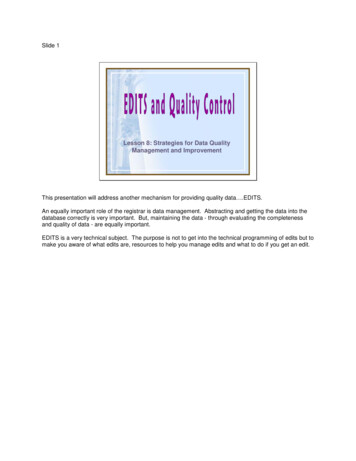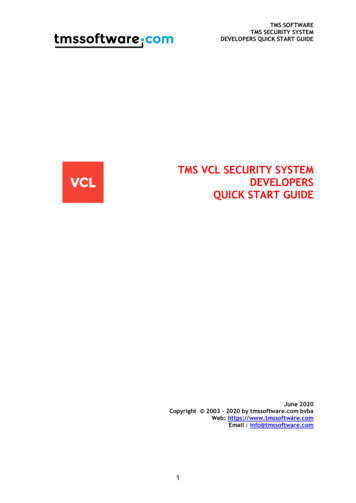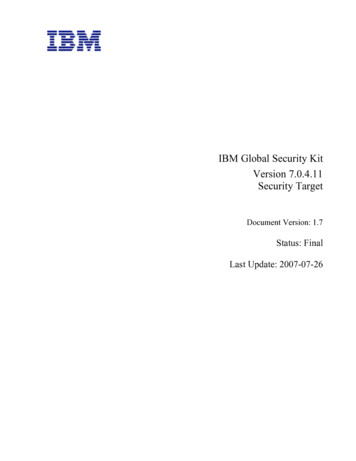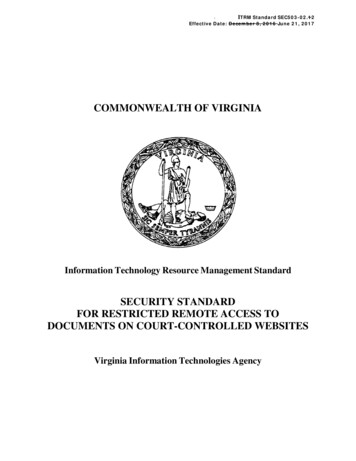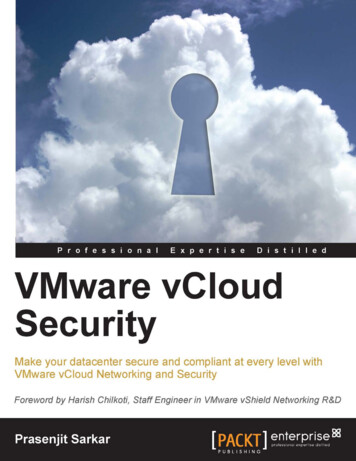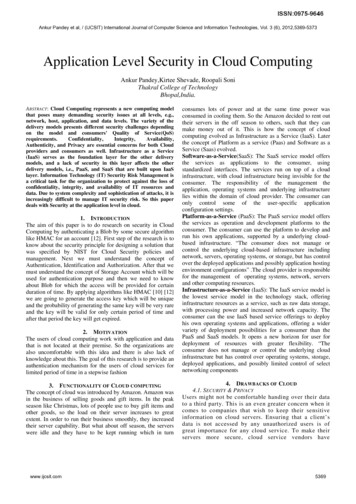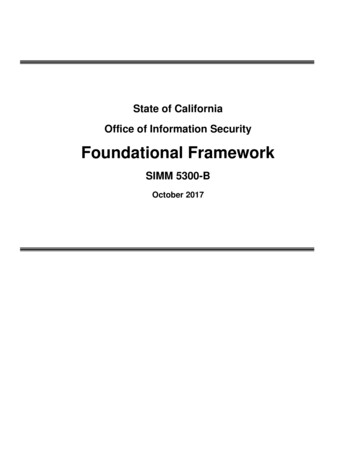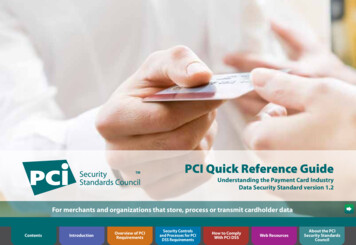
Transcription
PCI Quick Reference GuideUnderstanding the Payment Card IndustryData Security Standard version 1.2For merchants and organizations that store, process or transmit cardholder dataContentsIntroductionOverview of PCIRequirementsSecurity Controlsand Processes for PCIDSS RequirementsHow to ComplyWith PCI DSSWeb ResourcesAbout the PCISecurity StandardsCouncil
Copyright 2008 PCI Security Standards Council, LLC. All Rights Reserved.This Quick Reference Guide to the PCI Data Security Standard is provided by the PCI SecurityStandards Council to inform and educate merchants and other organizations that process, store ortransmit cardholder data. For more information about the PCI SSC and the standards we manage,please visit www.pcisecuritystandards.org.The intent of this document is to provide supplemental information, which does not replace orsupersede PCI Security Standards Council standards or their supporting documents. Full details canbe found on our Web site.03/09ContentsIntroductionOverview of PCIRequirementsSecurity Controlsand Processes for PCIDSS RequirementsHow to ComplyWith PCI DSSWeb ResourcesAbout the PCISecurity StandardsCouncil
ContentsIntroduction: Protecting Cardholder Data with PCI Security Standards . . 4Overview of PCI Requirements . 6PCI Data Security Standard (PCI DSS). 8Payment Application Data Security Standard (PA DSS). 10PIN Entry Device Security Requirements (PED). 10Security Controls and Processes for PCI DSS Requirements. 11Build and Maintain a Secure Network. 12Protect Cardholder Data. 14Maintain a Vulnerability Management Program. 16Implement Strong Access Control Measures. 18Regularly Monitor and Test Networks. 21Maintain an Information Security Policy. 23Compensating Controls for PCI Security. 24How to Comply with PCI DSS. 25Choosing a Qualified Security Assessor (QSA). 26Choosing an Approved Scanning Vendor (ASV). 27Using the Self-Assessment Questionnaire (SAQ). 28Reporting . 29Web Resources . 30About the PCI Security Standards Council . 313This Guide provides supplemental information that does not replace or supersede PCI DSS version 1.2 documents.ContentsIntroductionOverview of PCIRequirementsSecurity Controlsand Processes for PCIDSS RequirementsHow to ComplyWith PCI DSSWeb ResourcesAbout the PCISecurity StandardsCouncil
Introduction: Protecting Cardholder Data withPCI Security StandardsThe twentieth century U.S. criminal Willie Sutton was said to rob banks because “that’s where themoney is.” The same motivation in our digital age makes merchants the new target for financialfraud. Occasionally lax security by some merchants enables criminals to easily steal and use personalconsumer financial information from payment card transactions and processing systems.It’s a serious problem – more than 234 million records with sensitive information have been breachedsince January 2005, according to Privacy Rights Clearinghouse.org. As a merchant, you are at thecenter of payment card transactions so it is imperative that you use standard security procedures andtechnologies to thwart theft of cardholder data.Merchant-based vulnerabilities may appear almost anywhere in the card-processing ecosystemincluding point-of-sale devices; personal computers or servers; wireless hotspots or Web shoppingapplications; in paper-based storage systems; and unsecured transmission of cardholder data toservice providers. Vulnerabilities may even extend to systems operated by service providers andacquirers, which are the financial institutions that initiate and maintain the relationships withmerchants that accept payment cards (see diagram on page 5).Risky BehaviorA survey of businesses in the U.S.and Europe reveals activities thatmay put cardholder data at risk.81% store payment cardnumbers73% store payment cardexpiration dates71% store payment cardverification codes57% store customer data fromthe payment card magnetic stripe16% store other personal dataSource: Forrester Consulting: The Stateof PCI Compliance (commissioned byRSA/EMC)Compliance with the Payment Card Industry (PCI) Data Security Standard (DSS) helps to alleviatethese vulnerabilities and protect cardholder data.4This Guide provides supplemental information that does not replace or supersede PCI DSS version 1.2 documents.ContentsIntroductionOverview of PCIRequirementsSecurity Controlsand Processes for PCIDSS RequirementsHow to ComplyWith PCI DSSWeb ResourcesAbout the PCISecurity StandardsCouncil
INTERNETPUBLIC NETWORKSWIRELESSPOSINTERNETPUBLIC NETWORKSWIRELESSMerchantINTERNETPUBLIC NETWORKSWIRELESSService ProviderAcquirerThe intent of this PCI Quick Reference Guide is to help you understand the PCI DSS and to apply it toyour payment card transaction environment.There are three ongoing steps for adhering to the PCI DSS: Assess — identifying cardholderdata, taking an inventory of your IT assets and business processes for payment card processing,and analyzing them for vulnerabilities that could expose cardholder data. Remediate — fixingvulnerabilities and not storing cardholder data unless you need it. Report — compiling andsubmitting required remediation validation records (if applicable), and submitting compliance reportsto the acquiring bank and card brands you do business with.PCI COMPLIANCE IS ACONTINUOUS PROCESSASSESSREMEDIATEREPORTPCI DSS follows common sense steps that mirror best security practices. The DSS globally applies toall entities that store, process or transmit cardholder data. PCI DSS and related security standardsare administered by the PCI Security Standards Council, which was founded by American Express,Discover Financial Services, JCB International, MasterCard Worldwide and Visa Inc. Participatingorganizations include merchants, payment card issuing banks, processors, developers and othervendors.5This Guide provides supplemental information that does not replace or supersede PCI DSS version 1.2 documents.ContentsIntroductionOverview of PCIRequirementsSecurity Controlsand Processes for PCIDSS RequirementsHow to ComplyWith PCI DSSWeb ResourcesAbout the PCISecurity StandardsCouncil
Overview of PCI RequirementsPCI security standards are technical and operational requirements set by the PCI Security StandardsCouncil (PCI SSC) to protect cardholder data. The standards apply to all organizations that store,process or transmit cardholder data – with guidance for software developers and manufacturersof applications and devices used in those transactions. The Council is responsible for managingthe security standards, while compliance with the PCI set of standards is enforced by the foundingmembers of the Council, American Express, Discover Financial Services, JCB International, MasterCardWorldwide and Visa Inc.PAYMENT CARD INDUSTRY SECURITY STANDARDSProtection of Cardholder Payment DataMANUFACTURERSSOFTWAREDEVELOPERSPCI PEDPCI PA-DSSPIN Entry DevicesPayment ApplicationVendorsMERCHANTS &PROCESSORSPCI DSSData SecurityStandardPCI SECURITYSTANDARDS& COMPLIANCEEcosystem of payment devices, applications, infrastructure and users6This Guide provides supplemental information that does not replace or supersede PCI DSS version 1.2 documents.ContentsIntroductionOverview of PCIRequirementsSecurity Controlsand Processes for PCIDSS RequirementsHow to ComplyWith PCI DSSWeb ResourcesAbout the PCISecurity StandardsCouncil
PCI Security Standards Include:PCI Data Security Standard (DSS)The PCI DSS applies to all entities that store, process, and/or transmit cardholder data. It coverstechnical and operational system components included in or connected to cardholder data. If you area merchant who accepts or processes payment cards, you must comply with the PCI DSS.PIN Entry Device (PED) Security RequirementsPCI PED applies to manufacturers who specify and implement device characteristics and managementfor personal identification number (PIN) entry terminals used for payment card financial transactions.Merchants should use only PIN entry devices that are tested and approved by the PCI SSC. Authorizeddevices are listed at: www.pcisecuritystandards.org/security standards/ped/pedapprovallist.htmlPayment Application Data Security Standard (PA-DSS)The PA-DSS is for software developers and integrators of payment applications that store, processor transmit cardholder data as part of authorization or settlement when these applications are sold,distributed or licensed to third parties. Most card brands encourage merchants to use paymentapplications that are tested and approved by the PCI SSC. Validated applications are listed at:www.pcisecuritystandards.org/security standards/pa dss.shtml7This Guide provides supplemental information that does not replace or supersede PCI DSS version 1.2 documents.ContentsIntroductionOverview of PCIRequirementsSecurity Controlsand Processes for PCIDSS RequirementsHow to ComplyWith PCI DSSWeb ResourcesAbout the PCISecurity StandardsCouncil
The PCI Data Security StandardThe PCI DSS version 1.2 is the global data security standard adopted by the card brands for allorganizations that process, store or transmit cardholder data. It consists of common sense steps thatmirror best security practices.GoalsPCI DSS RequirementsBuild and Maintain a SecureNetwork1.2.Install and maintain a firewall configuration to protect cardholderdataDo not use vendor-supplied defaults for system passwords andother security parametersProtect Cardholder Data3.4.Protect stored cardholder dataEncrypt transmission of cardholder data across open, publicnetworksMaintain a VulnerabilityManagement Program5.6.Use and regularly update anti-virus software or programsDevelop and maintain secure systems and applicationsImplement Strong AccessControl Measures7.8.9.Restrict access to cardholder data by business need-to-knowAssign a unique ID to each person with computer accessRestrict physical access to cardholder dataRegularly Monitor and TestNetworks10.11.Maintain an InformationSecurity Policy12.Track and monitor all access to network resources and cardholderdataRegularly test security systems and processesMaintain a policy that addresses information security foremployees and contractors8This Guide provides supplemental information that does not replace or supersede PCI DSS version 1.2 documents.ContentsIntroductionOverview of PCIRequirementsSecurity Controlsand Processes for PCIDSS RequirementsHow to ComplyWith PCI DSSWeb ResourcesAbout the PCISecurity StandardsCouncil
Tools for Assessing Compliance with PCI DSSThe PCI SSC sets the PCI DSS standard, but each card brand has its own program for compliance,validation levels and enforcement. More information about compliance can be found at these links: American Express: www.americanexpress.com/datasecurityDiscover Financial Services: www.discovernetwork.com/fraudsecurity/disc.htmlJCB International: d Worldwide: www.mastercard.com/sdpVisa Inc: www.visa.com/cispVisa Europe: www.visaeurope.com/aisQualified Assessors. The Council manages programs that will help facilitate the assessment ofcompliance with PCI DSS: Qualified Security Assessor (QSA) and Approved Scanning Vendor (ASV).QSAs are approved by the Council to assess compliance with the PCI DSS. ASVs are approved by theCouncil to validate adherence to the PCI DSS scan requirements by performing vulnerability scans ofInternet-facing environments of merchants and service providers. Additional details can be found onour Web site at: www.pcisecuritystandards.org/qsa asv/find one.shtmlSelf-Assessment Questionnaire. The “SAQ” is a validation tool for organizations that are notrequired to undergo an on-site assessment for PCI DSS compliance. Different SAQs are specified forvarious business situations; more details can found on our Web site at:www.pcisecuritystandards.org/saq/index.shtml. The organization’s acquiring financial institution canalso determine if it should complete a SAQ.9This Guide provides supplemental information that does not replace or supersede PCI DSS version 1.2 documents.ContentsIntroductionOverview of PCIRequirementsSecurity Controlsand Processes for PCIDSS RequirementsHow to ComplyWith PCI DSSWeb ResourcesAbout the PCISecurity StandardsCouncil
Payment Application Data Security StandardThe PA-DSS is a standard for developers of payment applications. Its goal is to help development ofsecure commercial payment applications that do not store prohibited data, and ensure that paymentapplications support compliance with the PCI DSS. Merchants and service providers should ensurethat they are using Council-approved payment applications; check with your acquiring financialinstitution to understand requirements and associated timeframes for implementing approvedapplications. PA-DSS has 14 requirements: For details and a list of approved Payment Applications,see: www.pcisecuritystandards.org/security standards/pa dss.shtmlPIN Entry Device (PED) Security RequirementsThis standard, referred to as PED, applies to companies which make devices that accept personalidentification number (PIN) entry for all PIN-based transactions. Certified PED laboratories validateadherence to the PED standard. Merchants and service providers should ensure that they are usingcertified PED devices; check with your acquiring financial institution to understand requirements andassociated timeframes for compliance. PED has requirements for device characteristics and for devicemanagement. For details and a list of approved PIN Entry Devices, see:www.pcisecuritystandards.org/security standards/ped/index.shtml10This Guide provides supplemental information that does not replace or supersede PCI DSS version 1.2 documents.ContentsIntroductionOverview of PCIRequirementsSecurity Controlsand Processes for PCIDSS RequirementsHow to ComplyWith PCI DSSWeb ResourcesAbout the PCISecurity StandardsCouncil
Security Controls and Processes forPCI DSS RequirementsThe goal of the PCI Data Security Standard version 1.2 (PCI DSS) is to protect cardholder data thatis processed, stored or transmitted by merchants. The security controls and processes required byPCI DSS are vital for protecting cardholder account data, including the PAN – the primary accountnumber printed on the front of a payment card. Merchants and any other service providers involvedwith payment card processing must never store sensitive authentication data after authorization. Thisincludes sensitive data that is printed on a card, or stored on a card’s magnetic stripe or chip – andpersonal identification numbers entered by the cardholder. This chapter presents the objectives of PCIDSS and related 12 requirements.Types of Data on a Payment CardCID(American Express)CAV2/CID/CVC2/CVV2(Discover, JCB, MasterCard, Visa)Chip(data on magneticstripe image)PANExpiration DateMagnetic Stripe(data on tracks 1 & 2)11This Guide provides supplemental information that does not replace or supersede PCI DSS version 1.2 documents.ContentsIntroductionOverview of PCIRequirementsSecurity Controlsand Processes for PCIDSS RequirementsHow to ComplyWith PCI DSSWeb ResourcesAbout the PCISecurity StandardsCouncil
Build and Maintain a Secure NetworkIn the past, theft of financial records required a criminal to physically enter an organization’s businesssite. Now, many payment card transactions (such as debit in the U.S. and “chip and pin” in Europe)use PIN entry devices and computers connected by networks. By using network security controls,organizations can prevent criminals from virtually accessing payment system networks and stealingcardholder data.Requirement 1: Install and maintain a firewall and router configuration to protectcardholder dataFirewalls are devices that control computer traffic allowed into and out of an organization’s network,and into sensitive areas within its internal network. Routers are hardware or software that connectstwo or more networks.CONTROLS FORNETWORK SECURITYFirewallDevice that controls the passageof traffic between networks andwithin an internal network1.1 Establish firewall and router configuration standards that formalize testing wheneverconfigurations change; that identify all connections to cardholder data (including wireless); thatuse various technical settings for each implementation; and stipulate a review of configurationrule sets at least every six months.1.2 Build a firewall configuration that denies all traffic from “untrusted” networks and hosts, exceptfor protocols necessary for the cardholder data environment.1.3 Prohibit direct public access between the Internet and any system component in the cardholderdata environment.1.4 Install personal firewall software on any mobile and/or employee-owned computers with directconnectivity to the Internet that are used to access the organization’s network.RouterHardware or software that connectstraffic between two or morenetworksIllustration / Photo: Wikimedia Commons12This Guide provides supplemental information that does not replace or supersede PCI DSS version 1.2 documents.ContentsIntroductionOverview of PCIRequirementsSecurity Controlsand Processes for PCIDSS RequirementsHow to ComplyWith PCI DSSWeb ResourcesAbout the PCISecurity StandardsCouncil
Requirement 2: Do not use vendor-supplied defaults for system passwords and othersecurity parametersThe easiest way for a hacker to access your internal network is to try default passwords or exploitsbased on default system software settings in your payment card infrastructure. Far too often,merchants do not change default passwords or settings upon deployment. This is akin to leaving yourstore physically unlocked when you go home for the night. Default passwords and settings for mostnetwork devices are widely known. This information, combined with hacker tools that show whatdevices are on your network can make unauthorized entry a simple task – if you have failed to changethe defaults.2.1 Always change vendor-supplied defaults before installing a system on the network. This includeswireless devices that are connected to the cardholder data environment or are used to transmitcardholder data.2.2 Develop configuration standards for all system components that address all known securityvulnerabilities and are consistent with industry-accepted definitions.2.3 Encrypt all non-console administrative access such as browser/Web-based management tools.2.4 Shared hosting providers must protect each entity’s hosted environment and cardholderdata (details are in PCI DSS Appendix A: “Additional PCI DSS Requirements for Shared HostingProviders.”)TYPICAL DEFAULTPASSWORDS THAT MustBE CHANGED[none][name of product / vendor]1234 or sswordrootsasecretsysadminuser13This Guide provides supplemental information that does not replace or supersede PCI DSS version 1.2 documents.ContentsIntroductionOverview of PCIRequirementsSecurity Controlsand Processes for PCIDSS RequirementsHow to ComplyWith PCI DSSWeb ResourcesAbout the PCISecurity StandardsCouncil
Protect Cardholder DataENCRYPTION PRIMERCardholder data refers to any information printed, processed, transmitted or stored in any form on apayment card. Organizations accepting payment cards are expected to protect cardholder data andto prevent their unauthorized use – whether the data is printed or stored locally, or transmitted over apublic network to a remote server or service provider.Cryptography uses a mathematicalformula to render plaintext dataunreadable to people withoutspecial knowledge (called a “key”).Cryptography is applied to storeddata as well as data transmittedover a network.Requirement 3: Protect stored cardholder dataIn general, no cardholder data should ever be stored unless it’s necessary to meet the needs of thebusiness. Sensitive data on the magnetic stripe or chip must never be stored. If your organizationstores PAN, it is crucial to render it unreadable (see 3.4, and table below for guidelines).3.1 Limit cardholder data storage and retention time to that required for business, legal, and/orregulatory purposes, as documented in your data retention policy.Encryption changes plaintext intociphertext.Decryption changes ciphertextback into plaintext.3.2 Do not store sensitive authentication data after authorization (even if it is encrypted). Seeguidelines in table below.3.3 Mask PAN when displayed; the first six and last four digits are the maximum number of digitsyou may display. Not applicable for authorized people with a legitimate business need to seethe full PAN. Does not supersede stricter requirements in place for displays of cardholder datasuch as on a point-of-sale receipt.Illustration: Wikimedia Commons3.4 Render PAN, at minimum, unreadable anywhere it is stored – including on portable digitalmedia, backup media, in logs, and data received from or stored by wireless networks.Technology solutions for this requirement may include strong one-way hash functions,truncation, index tokens, securely stored pads, or strong cryptography. (See PCI DSS Glossary fordefinition of strong cryptography.)14This Guide provides supplemental information that does not replace or supersede PCI DSS version 1.2 documents.ContentsIntroductionOverview of PCIRequirementsSecurity Controlsand Processes for PCIDSS RequirementsHow to ComplyWith PCI DSSWeb ResourcesAbout the PCISecurity StandardsCouncil
3.5 Protect cryptographic keys used for encryption of cardholder data from disclosure and misuse.3.6 Fully document and implement all appropriate key management processes and procedures forcryptographic keys used for encryption of cardholder data.Guidelines for Cardholder Data ElementsStoragePermittedData ElementCardholder PCI DSSReq. 3.4Primary Account Number (PAN)YesYesYesCardholder Name1YesYes1NoService CodeYesYes1NoExpiration Date1YesYes1NoNoN/AN/ACAV2 / CVC2 / CVV2 / CIDNoN/AN/APIN / PIN BlockNoN/AN/A13Full Magnetic Stripe Data1These data elements must be protected if stored in conjunction with the PAN. This protection should be per PCI DSSrequirements for general protection of the cardholder data environment. Additionally, other legislation (for example,related to consumer personal data protection, privacy, identity theft, or data security) may require specific protection ofthis data, or proper disclosure of a company’s practices if consumer-related personal data is being collected during thecourse of business. PCI DSS, however, does not apply if PANs are not stored, processed, or transmitted.2Sensitive authentication data must not be stored after authorization (even if encrypted).3Full track data from the magnetic stripe, magnetic stripe image on the chip, or elsewhere.15This Guide provides supplemental information that does not replace or supersede PCI DSS version 1.2 documents.ContentsIntroductionOverview of PCIRequirementsSecurity Controlsand Processes for PCIDSS RequirementsHow to ComplyWith PCI DSSWeb ResourcesAbout the PCISecurity StandardsCouncil
Requirement 4: Encrypt transmission of cardholder data across open, public networksCyber criminals may be able to intercept transmissions of cardholder data over open, public networksso it is important to prevent their ability to view these data. Encryption is a technology used to rendertransmitted data unreadable by any unauthorized person.4.1 Use strong cryptography and security protocols such as SSL/TLS or IPSEC to safeguard sensitivecardholder data during transmission over open, public networks (e.g. Internet, wirelesstechnologies, global systems for communications [GSM], general packet radio systems [GPRS]).Ensure wireless networks transmitting cardholder data or connected to the cardholder dataenvironment use industry best practices (e.g., IEEE 802.11ix) to implement strong encryptionfor authentication and transmission. For new wireless implementations, it is prohibited toimplement WEP after March 31, 2009. For current implementations, it is prohibited to use WEPafter June 30, 2010.VULNERABILITYMANAGEMENTCreate policy governing securitycontrols according to industrystandard best practices (e.g., IEEE802.11ix)Regularly scan systems forvulnerabilities4.2 Never send unencrypted PANs by end user messaging technologies.Maintain a Vulnerability Management ProgramVulnerability management is the process of systematically and continuously finding weaknesses in anorganization’s payment card infrastructure system. This includes security procedures, system design,implementation, or internal controls that could be exploited to violate system security policy.Requirement 5: Use and regularly update anti-virus software or programsMany vulnerabilities and malicious viruses enter the network via employees’ e-mail and other onlineactivities. Anti-virus software must be used on all systems affected by malware to protect systemsfrom current and evolving malicious software threats.Create remediation schedulebased on risk and priorityPre-test and deploy patchesRescan to verify complianceUpdate security software withthe most current signatures andtechnologyUse only software or systemsthat were securely developed byindustry standard best practices16This Guide provides supplemental information that does not replace or supersede PCI DSS version 1.2 documents.ContentsIntroductionOverview of PCIRequirementsSecurity Controlsand Processes for PCIDSS RequirementsHow to ComplyWith PCI DSSWeb ResourcesAbout the PCISecurity StandardsCouncil
5.1 Deploy anti-virus software on all systems affected by malicious software (particularly personalcomputers and servers).5.2 Ensure that all anti-virus mechanisms are current, actively running, and capable of generatingaudit logs.Requirement 6: Develop and maintain secure systems and applicationsSecurity vulnerabilities in systems and applications may allow criminals to access PAN and othercardholder data. Many of these vulnerabilities are eliminated by installing vendor-provided securitypatches, which perform a quick-repair job for a specific piece of programming code. All criticalsystems must have the most recently released software patches to prevent exploitation. Organizationsshould apply patches to less-critical systems as soon as possible, based on a risk-based vulnerabilitymanagement program. Secure coding practices for developing payments applications, changecontrol procedures and other secure software development practices should always be followed.6.1 Ensure that all system components and software have the latest vendor-supplied securitypatches installed. Deploy critical patches within a month of release.6.2 Establish a process to identify newly discovered security vulnerabilities, such as by subscribingto alert services, or using a vulnerability scanning service or software. Update the process toaddress new vulnerability issues.6.3 Develop software applications in accordance with PCI DSS based on industry best practices andincorporate information security throughout the software development life cycle.6.4 Follow change control procedures for all changes to system components.17This Guide provides supplemental information that does not replace or supersede PCI DSS version 1.2 documents.ContentsIntroductionOverview of PCIRequirementsSecurity Controlsand Processes for PCIDSS RequirementsHow to ComplyWith PCI DSSWeb ResourcesAbout the PCISecurity StandardsCouncil
6.5 Develop all Web applications based on secure coding guidelines and review custom applicationcode to identify coding vulnerabilities.RESTRICTING ACCESSIS CRUCIAL!6.6 Ensure that all public Web-facing applications are protected against known attacks with at leastannual reviews of code, and by installing a Web application firewall in front of public-facing Webapplications.Implement Strong Access Control MeasuresAccess control allows merchants to permit or deny the use of physical or technical means to accessPAN and other cardholder data. Access must be granted on a business need-to-know basis. Physicalaccess control entails the use of locks or restricted access to paper-based cardholder records or systemhardware.
This Guide provides supplemental information that does not replace or supersede PCI DSS version 1.2 documents. 5 The intent of this PCI Quick Reference Guide is to help you understand the PCI DSS and to apply it to your payment card transaction environment. There are three ongoing steps for adhering to the PCI DSS: Assess — identifying cardholder

